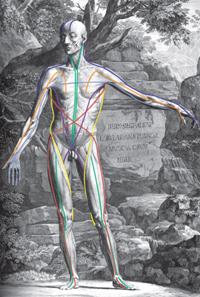I have read a few blogs recently on fascia. All of them giving a different perspective on what is a very prevalent topic at the moment.
One was based around the significance of fascial contraction and the biomechanical influence it could exert on the body. This made me think of the a pair of articles and an audio presentation I wrote for PTontheNet. In these articles I posed the question "how would fascia contract".
As far as I am aware fascia seems to mainly afferent, sending information to the CNS, rather than being able to efferently regulate tension through the feedback loop of muscle spindles and motor units. So if fascia does actively contract then why and is an active biomechanical influence helpful??
Chemical contraction has been noted in vitro (out of the body) in rat fascia (schliep 2006). These changes in response to chemical factors were in this case due to calcium chloride, calcium being involved in both skeletal and smooth muscle contraction although in different ways.
I think the link between the biochemical and biomechanical is an important one. Stress creates significant biochemical changes in the body. Hormones associated with stress such as cortisol are also involved in energy regulation. The body in response to long term stressors and increased energy expenditure may choose to decrease movement to conserve energy. This could be looked at as another way of interpreting the law of energy conservation on a metabolic level!!
One way of decreasing movement could be to increase the stiffness of the body. Fascia in its various forms being ubiquitous in the body could certainly play a role in this longer term stiffness regulation that would require less instantaneous neurological control than involved in active muscle contraction.
Now this maybe good for the body on one level (energy), maybe not so good on another (movement). So the biomechanical impact of stiffness regulation for fascia may be detrimental for our movement, especially if it becomes a learned response of the body and becomes the 'default' tension even when under less stress as I believe can happen.
Some may argue that increased compression through contraction of fascia at the lumbar spine is helpful. However this may not be the case if the movement at our hips is also reduced. The ball and socket joint of the hip is designed to have a large movement potential especially in the transverse plane. If this motion is reduced, through fascial stiffness, more motion may have to come from the lumbar area to achieve function related movement. Lumbar rotation is limited (by facet orientation) to 5 degrees collectively in all the 5 vertebrae!!
This could be a recipe for increased articular surface compression if the superior segment rotation (driven by top down movement) is not in close sequence with inferior segment rotation. If both rotate similar amounts then less compression. If one is blocked then this will increase compressive force between the two segments. If we put our hands one in front of the other and rotate them together we feel less compression. Try moving one and keeping the other still, this will increase compression. If the pelvis is not able to rotate on the femur then the inferior lumbar segment closest to the hip will be blocked. This will lead to increased compressive forces and possibly also to pain!
It does however give an insight into why some people have chronic movement dysfunctions that cannot be treated by biomechanical intervention alone without looking at biochemical, nutritional or emotional factors.
I also think we overlook the passive role that fascial stiffness plays in the body. Is passive resistance to movement as important as active contraction?? I personally think so. Our passive stiffness controls the range, speed and energy consumption of our movement. This seems to be overlooked in a similar way to eccentric muscle contraction controlling our movement by decelerating our momentum and controlling forces.
The differing types of collagen contained in different fascia may give slightly different interactions with energy. Some stiffer varieties maybe able to store and return energy whilst others may exert their stiff properties before plastically deforming and having their shape reset by muscle force.
This model would be quicker and more energy efficient than active contraction, neurological or chemical. The force of the movement (hopefully) dictating the correct response of the tissue.
As always this is merely my simple opinion on a complex clinical subject. I have also tried to give a perspective using a functional movement context.
Ben!!









